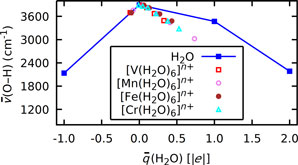Article contents
The role of solvent charge donation in the stabilization of metal ions in aqueous solution
Published online by Cambridge University Press: 17 August 2018
Abstract

We analyze charge density transfer from water to solvated transition metal (TM) ions in different formal oxidation states (FOSs) in aqueous solution by first principles and relate the degree of stabilization of the solvated cations to the charge donation from the water ligands. We find remarkable charge stability on the metal center regardless of FOSs. This effect is similar to what has previously been shown for charges on TM cations in inorganic crystals. This ligand-to-metal charge transfer results in softening of the ligand O–H bonds, which can be used to explain the formation of higher-FOS transition metalates and oxycations.
Information
- Type
- Research Letters
- Information
- Copyright
- Copyright © Materials Research Society 2018
References
1.Galstyan, G. and Knapp, E.-W.: Computing pKA values of hexa-aqua transition metal complexes. J. Comput. Chem. 36, 69 (2014).Google Scholar
2.Jarzȩcki, A.A., Anbar, A.D., and Spiro, T.G.: DFT analysis of Fe(H2O)63+ and Fe(H2O)62+ structure and vibrations; implications for isotope fractionation. J. Phys. Chem. A 108, 2726 (2004).Google Scholar
3.Marsh, B.M., Voss, J.M., Zhou, J., and Garand, E.: Coordination structure and charge transfer in microsolvated transition metal hydroxide clusters [MOH]+(H2O)1−4. Phys. Chem. Chem. Phys. 17, 23195 (2015).Google Scholar
4.Miliordos, E. and Xantheas, S.S.: Ground and excited states of the [Fe(H2O)6]2+ and [Fe(H2O)6]3+ clusters: insight into the electronic structure of the [Fe(H2O)6]2+–[Fe(H2O)6]3+ complex. J. Chem. Theory Comput. 11, 1549 (2015).Google Scholar
5.Varma, S. and Rempe, S.B.: Coordination numbers of alkali metal ions in aqueous solutions. Biophys. Chem. 124, 192 (2006).Google Scholar
6.Leenders, S.H.A.M., Gramage-Doria, R., de Bruin, B., and Reek, J.N.H.: Transition metal catalysis in confined spaces. Chem. Soc. Rev. 44, 433 (2015).Google Scholar
7.Pan, F. and Wang, Q.: Redox species of redox flow batteries: a review. Molecules 20, 20499–20517 (2015).Google Scholar
8.Jiang, Z., Klyukin, K., and Alexandrov, V.: Ab initio metadynamics study of the VO2+/VO2+ redox reaction mechanism at the graphite edge/water interface. ACS Appl. Mater. Interfaces 10, 20621 (2018).Google Scholar
9.Raebiger, H., Lany, S., and Zunger, A.: Charge self-regulation upon changing the oxidation state of transition metals in insulators. Nature 453, 763 (2008).Google Scholar
10.Wolczanski, P.T.: Flipping the oxidation state formalism: charge distribution in organometallic complexes as reported by carbon monoxide. Organometallics 36, 622 (2017).Google Scholar
11.Karen, P.: Oxidation state, a long-standing issue! Angew. Chem. Int. Ed. 54, 4716 (2015).Google Scholar
12.Karen, P., McArdle, P., and Takats, J.: Toward a comprehensive definition of oxidation state (IUPAC Technical Report). Pure Appl. Chem. 86, 1017 (2014).Google Scholar
13.Karen, P., McArdle, P., and Takats, J.: Comprehensive definition of oxidation state (IUPAC recommendations 2016). Pure Appl. Chem. 88, 831 (2016).Google Scholar
14.Koch, D. and Manzhos, S.: On the charge state of titanium in titanium dioxide. J. Phys. Chem. Lett. 8, 1593 (2017).Google Scholar
15.Koch, D. and Manzhos, S.: Addition to “on the charge state of titanium in titanium dioxide”. J. Phys. Chem. Lett. 8, 3945 (2017).Google Scholar
17.Griffith, J.S. and Orgel, L.E.: Ligand-field theory. Q. Rev. Chem. Soc. 11, 381 (1957).Google Scholar
18.Kramida, A., Ralchenko, Y., and Reader, J. and NIST ASD Team: NIST Atomic Spectra Database (ver. 5.5.6), [Online]. Available: https://physics.nist.gov/asd [June 30, 2018]. National Institute of Standards and Technology, Gaithersburg, MD (2018).Google Scholar
19.Cotton, F.A., Fair, C.K., Lewis, G.E., Mott, G.N., Ross, F.K., Schultz, A.J., and Williams, J.M.: Precise structural characterizations of the hexaaquovanadium(III) and diaquohydrogen ions. X-ray and neutron diffraction studies of [V(H2O)6][H5O2](CF3SO3)4. J. Am. Chem. Soc. 106, 5319 (1984).Google Scholar
20.Kallies, B. and Meier, R.: Electronic structure of 3d [M(H2O)6]3+ ions from ScIII to FeIII: a quantum mechanical study based on DFT computations and natural bond orbital analyses. Inorg. Chem. 40, 3101 (2001).Google Scholar
21.Sham, T.K., Hastings, J.B., and Perlman, M.L.: Structure and dynamic behavior of transition-metal ions in aqueous solution: an EXAFS study of electron-exchange reactions. J. Am. Chem. Soc. 102, 5904 (1980).Google Scholar
22.Koch, D., Golub, P., and Manzhos, S.: Stability of charges in titanium compounds and charge transfer to oxygen in titanium dioxide. J. Phys. Conf. Ser. in print (arXiv preprint arXiv:1807.00115) (2018).Google Scholar
23.Bertrand, G.L., Stapleton, G.W., Wulff, C.A., and Hepler, L.G.: Thermochemistry of aqueous pervanadyl and vanadyl ions. Inorg. Chem. 5, 1283 (1966).Google Scholar
24.Ballhausen, C.J. and Gray, H.B.: The electronic structure of the vanadyl Ion. Inorg. Chem. 1, 111 (1962).Google Scholar
25.Alotto, P., Guarnieri, M., and Moro, F.: Redox flow batteries for the storage of renewable energy: a review. Renewable Sustainable Energy Rev. 29, 325 (2014).Google Scholar
- 9
- Cited by


